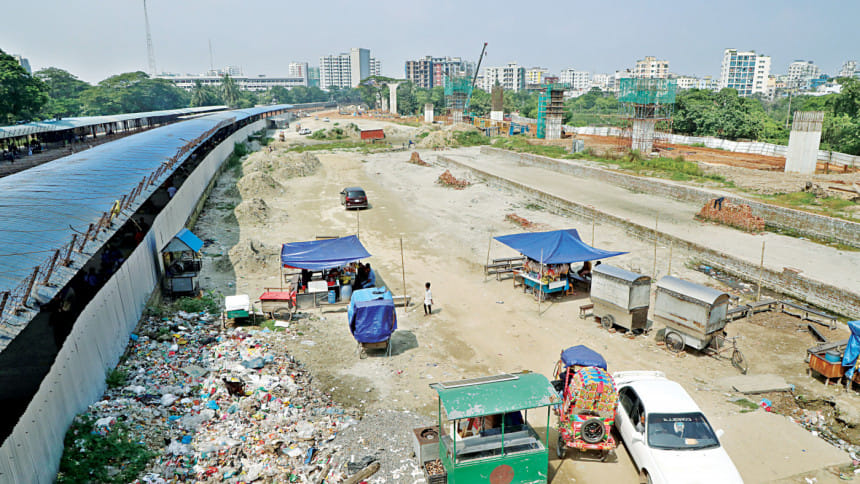Waterlogging in airport area: Railway filling up waterbody makes things worse

People of many areas across the country are dealing with waterlogging and those in the capital's Airport area are no exceptions.
Over six months ago, the Bangladesh Railway authorities filled up a waterbody near the Airport Railway Station as part of the Dhaka-Tongi-Joydebpur railway expansion project. Due to this, areas in Uttara, Ashkona, Dakshinkhan and even the airport premises face severe waterlogging during the rainy reason, causing immense sufferings to people in those neighbourhoods.
Under the project, two additional lines and platforms for passengers are to be built in the area.
The waterbody played a vital role in containing rainwater and mitigating flooding during the monsoon.
Environmentalists have raised concerns and warned that filling up waterbodies in the city can have severe impact on biodiversity and can hamper flood control.
Sharmin Begum, of the Airport area, said, "The railway authorities' actions have left our homes and streets flooded. Do they even care about the misery they're causing?"
Al Mamun, a resident of Uttara sector-2, said, "The recent rains had caused waterlogging around my house like never before. The flooding has now become constant whenever it rains."
In response to the situation, Dhaka North City Corporation wrote to the railway ministry on June 13 this year, highlighting that even a drizzle was causing waterlogging due to the waterbody being filled up.
Speaking to The Daily Star recently, DNCC Chief Executive Officer Mir Khairul Alam said, "After the railway authorities filled up the waterbody, we wrote to them asking them to restore the reservoir to its original state.
"We also requested the railway to make the box culvert at least three meters wide so that water can flow properly and meet future needs."
During a recent visit, this correspondent found that the railway project officials had fenced off the area and were using excavators to level the land, which had been entirely filled with dirt.
Several trees have also been felled.
Contacted, Nazneen Ara Keya, the project director, said blaming only the railway authorities for the waterlogging was not acceptable.
"To reduce waterlogging, the DNCC's drainage pipe is supposed to connect to a nearby canal via a culvert. However, the construction of the drainage pipeis not yet complete."
Work on both projects -- the city corporation's drain construction and the railway's culvert construction -- are yet to be finished, she added.
"There was a small ditch here that railway authorities filled for the project work. Once completed, it will benefit the public. No buildings or railway offices are being constructed here."
Speaking to this correspondent recently, she further said that a meeting was held in which the city corporation requested them to make the culvert wider, increasing its width to three meters. The rail authorities agreed to this request.
"The contractors working on the project are currently in India, and once they come back, a new design will be made. If the box culvert is made wider, it will help prevent waterlogging."
In an interview with this newspaper in July, recently appointed Environment Adviser Syeda Rizwana Hasan highlighted the crucial role of waterbodies in retaining water during the monsoon.
She called upon the railway authorities to restore the waterbody.
Even if the railways owned the waterbody, they should not have filled it up without proper authorisation, she said.
"In metropolitan areas, the environment department and national housing authorities oversee such actions under the Environment Conservation Acts. However, as this area is filled up under the Detailed Area Plan, the city authorities are not supposed to approve such action.
"The railway authorities are engaging in illegal activity and sending a very bad message to society."

 For all latest news, follow The Daily Star's Google News channel.
For all latest news, follow The Daily Star's Google News channel. 



Comments